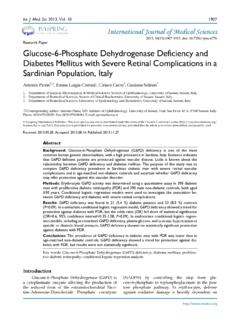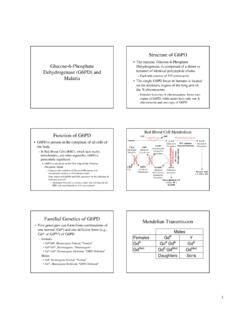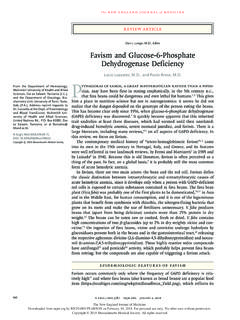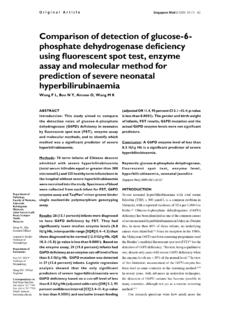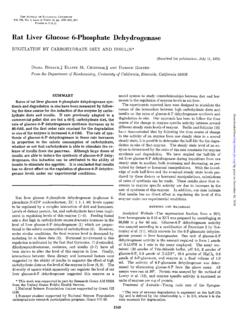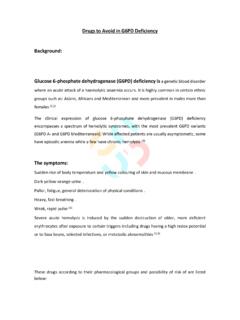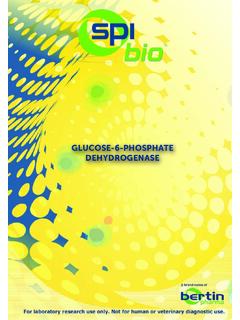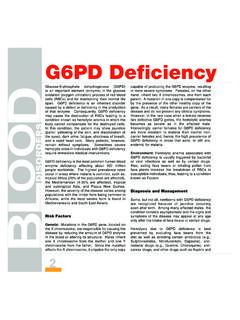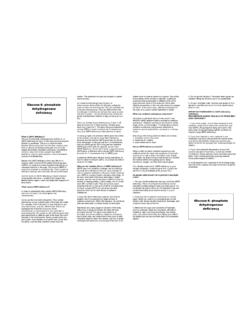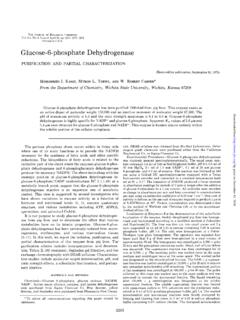Transcription of Glucose-6-Phosphate Dehydrogenase Deficiency and …
1 * Corresponding author: Ezzat Khodashenas Assistant Professor of Pediatrics, Department of Pediatrics, Faculty of Medicine, Mashhad University of Medical Sciences, Mashhad, Iran Tel: 09153011056; E-mail: Original Article Open Access Glucose-6-Phosphate Dehydrogenase Deficiency and Neonatal Hyperbilirubinemia Ezzat Khodashenas1*, Farnaz Kalani-Moghaddam2, Zohreh Araghi3, Mahvan Khodaparast3, Zahra Yazdani3 1. Assistant Professor of Pediatrics, Department of Pediatrics, Faculty of Medicine, Mashhad University of Medical Sciences, Mashhad, Iran 2.
2 Resident of Pediatrics, Department of Pediatrics, Faculty of Medicine, Mashhad University of Medical Sciences, Mashhad, Iran 3. Graduate Student of Neonatal Intensive Care nursing, Faculty of Nursing and Midwifery, Mashhad University of Medical Sciences, Mashhad, Iran ABSTRACT Background: Jaundice is affecting over 60-80 percent of neonates in the first week of life. Glucose-6-Phosphate Dehydrogenase (G6PD) Deficiency , which is an important cause of pathologic hyperbilirubinemia, can lead to hemolytic anemia, jaundice and kernicterus.
3 The present study was performed to determine the prevalence of G6PD Deficiency among icteric neonates in Shirvan, Iran. Methods: This descriptive, analytical study was performed by evaluating the medical records of neonates with jaundice, admitted to the neonatal ward of Imam Khomeini Hospital of Shirvan in 2012-2013. All neonates, who were evaluated in terms of G6PD, were included in this study. Data including the clinical signs and symptoms, laboratory test results and maternal history during pregnancy were recorded in the questionnaires.
4 The patients were divided into two groups: with and without G6PD Deficiency . The recorded data were compared between the two groups, using t-test and Chi-square test. P-value less than was considered statistically significant. Results: Among 452 admitted neonates, 16 ( ) presented with G6PD Deficiency . There was no significant difference between the two groups in terms of birth weight, weight on admission, Coombs test results, hematocrit level, length of hospital stay and total bilirubin level.
5 However, there was a significant difference between the two groups regarding reticulocyte count. Conclusion: Based on the findings, establishment of an early G6PD screening program, which can prevent further complications in neonates, seems essential, particularly in countries such as Iran where G6PD Deficiency is highly prevalent. Keywords: Glucose-6-Phosphate Dehydrogenase , Hyperbilirubinemia, Neonate IntroductionJaundice is a commonly reported condition in neonates. Approximately 60% of term and 80% of preterm neonates become icteric in the first week of life.
6 Although jaundice is mostly a physiological phenomenon, it necessitates admission and treatment in 10-12% of cases (1). In severe cases, jaundice can cause complications such as kernicterus, cerebral palsy and death. Consequently, determining the etiology of jaundice can lead to timely prevention and treatment of jaundice (1, 2). One of the known causes of neonatal jaundice is G6PD Deficiency . G6PD is a vital protective enzyme present in all body cells (2, 3). This type of Deficiency is the most common and important enzyme Deficiency in red blood cells.
7 Lack of G6PD might cause severe hyperbilirubinemia and increase the risk of kernicterus in neonates. Today, due to appropriate screening of ABO/Rh incompatibility, kernicterus is not normally accompanied by simultaneous blood group incompatibility; therefore, risk of complications has increased in neonates with G6PD Deficiency . In previous research, the prevalence of kernicterus was estimated at in G6PD deficient infants and 2% in healthy subjects (4). G6PD Deficiency was initially described in 1956.
8 So far, researchers have conducted various studies on this subject (5, 6). At least 400 different types of G6PD Deficiency with distinctive biochemical characteristics and about 100 various mutations have been recognized (7). G6PD Deficiency is a hereditary X-linked condition, with a male predominance. Jaundice arising from this Deficiency manifests as indirect hyperbilirubinemia. In some studies, the G6PD and neonatal hyperbilirubinemia Khodashenas E et al Iranian Journal of Neonatology 2015; 6(3) 29 prevalence of indirect hyperbilirubinemia resulting from G6PD Deficiency has been reported to be (8).
9 In most cases of hyperbilirubinemia caused by G6PD Deficiency , there is no definite finding compatible with hemolysis such as anemia or reticulocytosis. In some studies, a significant correlation has been reported between G6PD Deficiency and Gilbert s syndrome (9). Considering the importance of jaundice resulting from G6PD Deficiency and lack of research on this issue, we aimed to determine the prevalence of G6PD Deficiency in icteric neonates born in Shirvan, Iran.
10 The incidence rate of G6PD Deficiency ranges between 1% and 12% in Asian countries (10). In this study, we also compared the mean bilirubin level, length of hospital stay, duration of phototherapy, weight loss, exchange transfusion, audiometry test and other abnormal, jaundice-related laboratory test results between the two groups with and without G6PD Deficiency (case and control groups, respectively). Considering the high prevalence of jaundice and the significant difference in the obtained data between the two groups, we could indicate the necessity of G6PD screening tests for all newborns in Shirvan, Iran.
